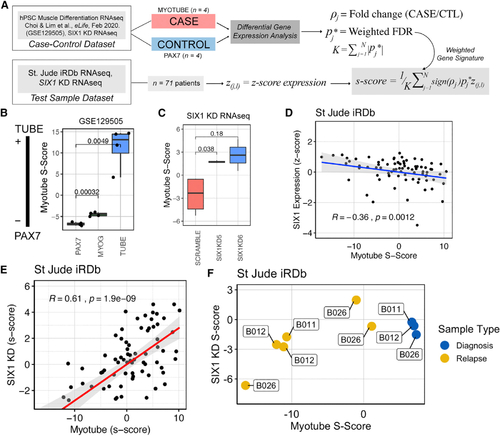Fig. 7
- ID
- ZDB-FIG-230219-27
- Publication
- Hsu et al., 2022 - SIX1 reprograms myogenic transcription factors to maintain the rhabdomyosarcoma undifferentiated state
- Other Figures
- All Figure Page
- Back to All Figure Page
|
SIX1 expression in RMS patients is inversely correlated with a myotube gene signature
(A) Overview of the S scoring methodology, where gene expression in the case-control data is used to generate a weighted gene signature to score test sample transcriptomes on a continuous scale. (B) Myotube S scores for samples used in the training set plotted as proof of concept that the myotube S score can quantify myogenic differentiation status. Statistical differences were measured by Student’s t test. (C) Myotube S scoring methodology applied to the SIX1 KD RNA-seq dataset, demonstrating that SIX1 KD cells are more advanced in the myogenic lineage than Scramble cells. Statistical differences were measured by Student’s t test. (D) Scatterplot of myotube S scores plotted against SIX1 Z score-converted expression and Spearman rank correlation coefficient show a moderate inverse correlation between differentiation status and SIX1 expression in St. Jude RMS samples (n = 71). (E) Scatterplot of SIX1 KD S scores derived from SIX1 KD RNA-seq data against myotube S score shows a strong positive correlation between the SIX1 KD and myotube gene signatures in the St. Jude RMS dataset. (F) Myotube and SIX1 KD S scores of three individuals, with biopsies collected at multiple stages of disease. |

